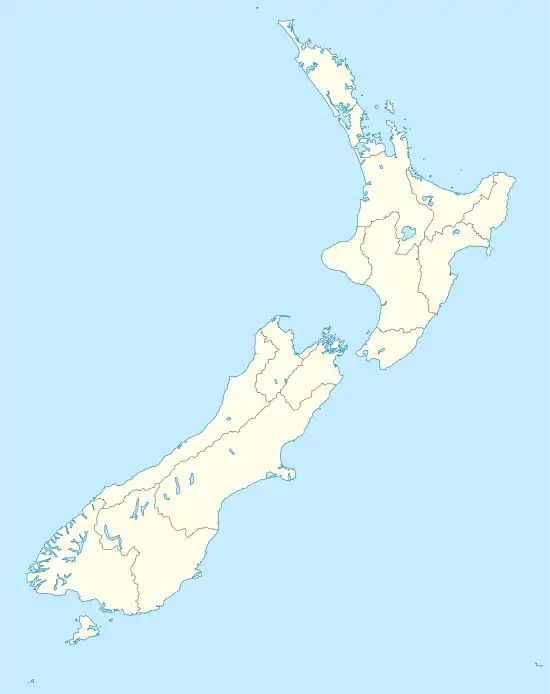Mangakino
Mangakino is a small town on the banks of the Waikato River in the North Island of New Zealand. It is located close to the hydroelectric power station at Lake Maraetai, 85 kilometres (53 mi) southeast of Hamilton. Its population in 2001 was 1257. The town and its infrastructure are administered as the Mangakino Pouakani ward by the Taupo District Council
Mangakino | |
|---|---|
Town | |
 Mangakino Location in New Zealand | |
| Coordinates: 38°22′10″S 175°46′30″E | |
| Country | |
| Island | North Island |
| Region | Environment Waikato |
| District | Taupo District |
| Settlements of Taupo | |
| Government | |
| • Type | Administered as a ward (Mangakino Pouakani) by the Taupo District Council |
| • Mayor | Rick Cooper |
| • Territorial Authority | Taupo District Council |
| • Regional Council | Environment Waikato |
| • Parliamentary electorate | Taupo |
| Area | |
| • Taupo District | 6,970 km2 (2,690 sq mi) |
| Population | |
| • Total | 1,257 |
| • Taupo District | 32,418 |
History and culture
In 1896, (after 40 years of resistance) the Crown acquired the Wairarapa Lakes from Ngāti Kahungunu and in 1915, gave in return land in middle North Island, land known as part of the Pouakani Block. At that time the land where Mangakino lies today was described as native bush and pumice wastelands, barren, unoccupied and unfarmed. In 1946, as the Karapiro Dam neared completion, workers were to transfer to the next dam construction site – 'Maraetai I', near Mangakino. The Crown, under the Public Works Act, reacquired a portion of the unoccupied Pouakani Block alongside the Waikato River to build a "hydroelectric station" and a temporary township, Mangakino, was established to house the hundreds of construction workers needed. The town was only ever meant to be there on a temporary basis until the completion of the proposed dams.[1]
The city planner Ernst Plischke who emigrated from Austria in 1939 developed a plan for the town centre of Mangakino, which was put into action in 1947–1948. His plan included a pedestrian area in the town centre free from through traffic.[2]
In 1952 the population exceeded 5,000. Mangakino also serviced the construction of Atiamuri and Ohakuri hydro schemes further upstream which were commissioned in 1959 and 1961 respectively. Mangakino and to a lesser extent Whakamaru and Atiamuri, owe their existence to the hydro schemes and the roads constructed gave access which allowed development of the land for farming in the 1960s. The decline for Mangakino occurred after the hydro dams were commissioned and over time communities such as Maraetai and Waipapa disappeared altogether.[1]
In 2001, the Mangakino Township Incorporation obtained approval through the Māori Land Court to legally change the title of the majority of residential sections in Mangakino from Māori land to General title. They then put Mangakino’s 500+ leasehold sections on the market as a single purchase. In July 2002, the majority of the town’s sections were sold to MV Properties of Pukekohe. A stipulation of the tender was that residents would be given the first opportunity to purchase their perpetually leased sections. The land valuations that had been exceedingly low for decades, then skyrocketed. Some locals chose to freehold their homes immediately, empty sections without current leases were sold on the open market. Many residents continue to remain perpetual leaseholders.[1]
Marae
Pouākani Marae and its meeting house, Tamatea Pokai Whenua, is a meeting place for Ngāti Kahungunu ki Wairarapa. The marae was first built in 1972 on land exchanged for Lake Wairarapa for Ngāti Kahungunu ki Wairarapa members and other Māori who were working on the dam.[3] The marae was destroyed by arson in 2007 but reopened in 2012 after five years of reconstruction.[4]
In October 2020, the Government committed $4,525,105 from the Provincial Growth Fund to upgrade Pouākani Marae and 9 other marae, creating 35 jobs.[5]
Miringa te Kakara Marae and Te Whetū Marama o Ngā Tau o Hinawa meeting house are a meeting place of Maniapoto and Rereahu.[6][7]
Education
Mangakino Area School is a co-educational Year 1–13 state area school,[8] with a roll of 37 as of March 2020.[9][10]
Notable residents
Prominent former citizens of Mangakino include:
- Willie Apiata VC, who was born there in 1972
- Mike Rann, Australian Ambassador and former Labor Premier of South Australia
- Ron Rangi, former All Black
- Sir Basil Arthur, former Minister of Transport, Labour Government.
- Hori Ahipene, actor
- Annabel Langbein, celebrity cook and food writer, born there in 1958
References
- "History of Mangakino". mangakino.net.nz. Mangakino SCAF.
- Mueckler, H. (Hsg.):Novara, Oesterreicher im Pazifik 2, Mitteilungen der Oesterreichisch – Suedpazifischen Gesellschaft Band 2, Vienna 1999, p. 61
- "Poukani Marae". pouakanimarae.nz. Poukani Charitable Trust.
- "Māori Maps". maorimaps.com. Te Potiki National Trust.
- "Marae Announcements" (Excel). growregions.govt.nz. Provincial Growth Fund. 9 October 2020.
- "Te Kāhui Māngai directory". tkm.govt.nz. Te Puni Kōkiri.
- "Māori Maps". maorimaps.com. Te Potiki National Trust.
- "Mangakino Area School Ministry of Education School Profile". educationcounts.govt.nz. Ministry of Education.
- "New Zealand Schools Directory". New Zealand Ministry of Education. Retrieved 26 April 2020.
- "Mangakino Area School Education Review Office Report". ero.govt.nz. Education Review Office.